
Mortal Kombat Annihilation is a 1997 American martial arts fantasy film directed by John R. Leonetti in his directorial debut. Based on the Mortal Kombat video game franchise, it is the second installment in the Mortal Kombat film series and a sequel to the original 1995 film, on which Leonetti served as cinematographer. Largely adapted from the 1995 video game Mortal Kombat 3, Annihilation follows Liu Kang and his allies as they attempt to prevent the malevolent Shao Kahn from conquering Earthrealm. It stars Robin Shou as Liu Kang, Talisa Soto as Kitana, James Remar as Raiden, Sandra Hess as Sonya Blade, Lynn “Red” Williams as Jax and Brian Thompson as Shao Kahn. Only Shou and Soto reprised their roles, with the other characters from the previous film being recast.
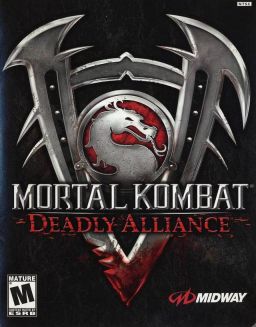
Mortal Kombat: Deadly Alliance is a 2002 fighting game developed and published by Midway for the Xbox, PlayStation 2, GameCube, and Game Boy Advance. It was the first all-new Mortal Kombat fighting game produced exclusively for home consoles, with no preceding arcade release. It is the fifth main installment in the Mortal Kombat franchise and a sequel to 1997's Mortal Kombat 4. Its story focuses on the eponymous alliance between sorcerers Quan Chi and Shang Tsung and their schemes to revive an ancient army to conquer Outworld and Earthrealm. The game is the only main installment not to feature series protagonist Liu Kang as a playable character. It is also the first game in the canon series to not have the involvement of co-creator John Tobias, as he left Midway in 1999 to pursue other interests.

Mortal Kombat 4 is a 1997 fighting game, the fourth main installment in the Mortal Kombat franchise, and a sequel to 1995's Mortal Kombat 3. It was developed by Midway Games. Released to arcades in 1997, Mortal Kombat 4 is the first title in the series, and one of the first made by Midway overall, to use 3D computer graphics. It is also the last game of the series to have an arcade release. It was ported to the PlayStation, Nintendo 64, PC, and Game Boy Color in 1998. An updated version titled Mortal Kombat Gold was released exclusively for the Dreamcast.

Sub-Zero is a title used by two characters in the Mortal Kombat fighting game franchise by Midway Games and NetherRealm Studios. They are depicted as two Chinese brothers and ninja warriors of the Lin Kuei clan, principally defined by their blue attire and ability to control ice in many forms. Both incarnations of Sub-Zero are the only series characters to have appeared in every main installment of the series, in addition to being featured as the protagonist of the 1997 spin-off Mortal Kombat Mythologies: Sub-Zero.

This is a list of playable and boss characters from the Mortal Kombat fighting game franchise and the games in which they appear. Created by Ed Boon and John Tobias, the series depicts conflicts between various realms. Most characters fight on behalf of their realm, with the primary heroes defending Earthrealm against conquering villains from Outworld and the Netherrealm. Early installments feature the characters participating in the eponymous Mortal Kombat tournament to decide their realm's fate. In later installments, Earthrealm is often invaded by force.
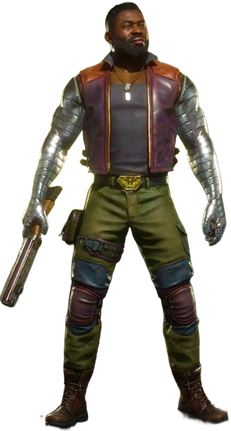
Jackson "Jax" Briggs is a fictional character in the Mortal Kombat fighting game franchise by Midway Games and NetherRealm Studios. Introduced in Mortal Kombat II (1993) as the leader of a Special Forces unit, he became a mainstay of the series, including as the protagonist of the action-adventure spin-off Mortal Kombat: Special Forces (2000). The character is distinguished by his metal bionic arms, which he first received in Mortal Kombat 3 (1995), and his abilities are based around his upper-body strength.

Mortal Kombat 3 is a 1995 arcade fighting game developed by Midway Games. It is the third main installment in the Mortal Kombat franchise and a sequel to 1993's Mortal Kombat II. As in the previous games, it has a cast of characters that players choose from and guide through a series of battles against other opponents. The game avoids the tournament storyline of its predecessors, as various warriors instead fight against the returning Shao Kahn, who has resurrected his bride Sindel and started an invasion of Earthrealm.
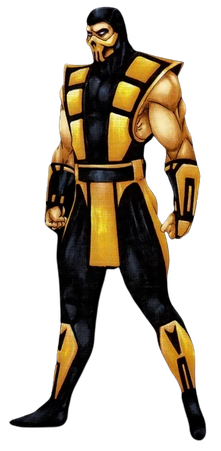
Scorpion is a character in the Mortal Kombat fighting game franchise by Midway Games and NetherRealm Studios. A ninja dressed in yellow, his primary weapon is a kunai rope dart, which he uses to harpoon opponents. Since his debut in the original 1992 game, Scorpion has appeared as a playable character in every main installment except Mortal Kombat 3 (1995).

Mortal Kombat Trilogy is a fighting game released by Midway in 1996 as the second and final update to Mortal Kombat 3 for the PlayStation, Nintendo 64, Sega Saturn and PCs. Further versions were also released for the Game.com and R-Zone. It features a similar basic gameplay system and the same story as Ultimate Mortal Kombat 3, but adds characters and stages restored from Mortal Kombat and Mortal Kombat II. New additions to the game included the "Aggressor" bar. The Brutality mechanic was introduced with this installment. The game was met with positive to mixed reviews upon release.
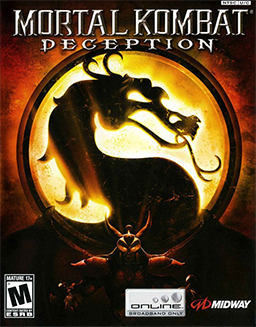
Mortal Kombat: Deception is a 2004 fighting game developed and published by Midway. It is the sixth main installment in the Mortal Kombat franchise and a sequel to 2002's Mortal Kombat: Deadly Alliance. It was released for the PlayStation 2 and Xbox in October 2004, for the GameCube in March 2005 and later ported for the PlayStation Portable under the title Mortal Kombat: Unchained in November 2006. Mortal Kombat: Deception follows the storyline from the fifth installment, Deadly Alliance. Its story centers on the revival of the Evil Dragon King Onaga, who attempts to conquer the realms featured in the series after defeating the sorcerers Quan Chi and Shang Tsung, the main antagonists in the previous game, and the Thunder God Raiden, defender of Earthrealm. The surviving warriors from the previous titles join forces to confront Onaga.
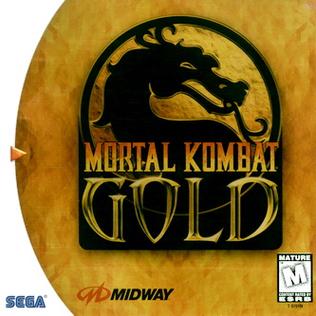
Mortal Kombat Gold is a 1999 fighting game in the Mortal Kombat series that was published by Midway Home Entertainment. It was developed by Eurocom and released exclusively on the Dreamcast as a launch title. It is an updated version of 1997's Mortal Kombat 4 and was the first game to appear on a sixth-generation platform as well as the only Mortal Kombat game to be released for the Dreamcast console. Critical reaction was mostly average due to the graphics being inferior to the arcade version, the weapons deemed boring or useless, and game-breaking bugs and glitches.

Mortal Kombat: Shaolin Monks is a 2005 action-adventure beat 'em up video game developed and published by Midway for the PlayStation 2 and Xbox. A spin-off of the Mortal Kombat franchise, it is a retelling of the events of Mortal Kombat II (1993). Players control the eponymous Shaolin monks Liu Kang and Kung Lao in either single player or cooperative play as they protect Earthrealm from the forces of Outworld.

Mortal Kombat: Armageddon is a 2006 fighting game and it is the seventh main installment in the Mortal Kombat franchise and a sequel to 2004's Mortal Kombat: Deception. The PlayStation 2 and Xbox versions were released in October 2006, with a Wii version released on May 29, 2007 in North America. The Xbox version was not released in PAL territories. Chronologically the final chapter in the original Mortal Kombat storyline, it features virtually every character from the previous games. Players select one of them and battle a selection of the other fighters. The story follows a warrior named Taven after being awakened who goes on a journey to defeat his evil brother leading up to the Armageddon war to determine the fate of the Mortal Kombat universe.

Mortal Kombat is an American media franchise centered on a series of fighting video games originally developed by Midway Games in 1992.
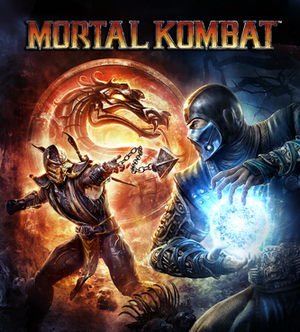
Mortal Kombat is a 2011 fighting game developed by NetherRealm Studios and published by Warner Bros. Interactive Entertainment. It is the ninth main installment in the Mortal Kombat series and a soft reboot of the series. The game was released for the PlayStation 3 and Xbox 360 systems in April 2011, and a PlayStation Vita port was released in May 2012. An expanded version of the game, titled Mortal Kombat: Komplete Edition, was released for Xbox 360 and PlayStation 3 in February 2012 and for Microsoft Windows in July 2013.
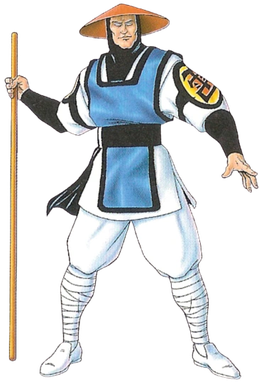
Raiden is a fictional character in the Mortal Kombat fighting game franchise by Midway Games and NetherRealm Studios. Based on the Japanese deity Raijin, he is depicted as the god of thunder who possesses control over lightning. He debuted in the original 1992 game and has appeared as a playable character in every main installment except Mortal Kombat 3 (1995) and its first update. In the storyline of the games, Raiden is the protector of Earthrealm. He fulfills his duty by selecting and training the warriors who defend Earthrealm from various threats, while also participating directly in the realm's defense. Raiden generally serves as a mentor figure to the franchise's heroes, although he sometimes assumes a darker role in the story, which sees him become more ruthless in his protection of the realm. One of the franchise's central characters, Raiden has appeared in various related media outside of the Mortal Kombat games, including guest appearances in NBA Jam Tournament Edition (1995), NFL Blitz (1997), Unreal Championship 2 (2005), and Injustice 2 (2017). He has generally received a positive reception and is among the series' most popular characters for his design and special abilities.

Mortal Kombat X is a 2015 fighting game developed by NetherRealm Studios and published by Warner Bros. Interactive Entertainment for PlayStation 4, Windows, and Xbox One. Versions for the PlayStation 3 and Xbox 360 were also due to release, but both versions were cancelled. It is the tenth main installment in the Mortal Kombat series and a sequel to Mortal Kombat (2011), taking place 25 years later after the events of its predecessor. High Voltage Software developed the Windows version of the game, with Polish studio QLOC taking over the work on it shortly after the release of Kombat Pack 1.
Mortal Kombat is an American series of martial arts action films based on the fighting video game series of the same name by Midway Games. The first film was produced by Lawrence Kasanoff’s Threshold Entertainment.

Mortal Kombat Legends: Scorpion's Revenge is a 2020 American direct-to-video adult animated martial arts film based on the Mortal Kombat franchise created by Ed Boon and John Tobias. South Korean studio Mir animated the film and was produced by Warner Bros. Animation. It is the first installment in the Legends series. Borrowing source material from Mortal Kombat, the film contains two plots: one dealing with Scorpion seeking his revenge on those who murdered his family and clan after being resurrected by Quan Chi, the other follows Johnny Cage, Liu Kang and Sonya Blade, who are chosen to participate on the Mortal Kombat tournament for the fate of Earthrealm.

Mortal Kombat Legends: Battle of the Realms is a 2021 American direct-to-video adult animated martial arts film, directed by Ethan Spaulding from a screenplay by Jeremy Adams, based on the Mortal Kombat franchise created by Ed Boon and John Tobias, it is the second installment in the Legends series and a direct sequel to Mortal Kombat Legends: Scorpion's Revenge (2020). Produced by Warner Bros. Animation and animated by Studio Mir, Boon returned from the predecessor as creative consultant.

















